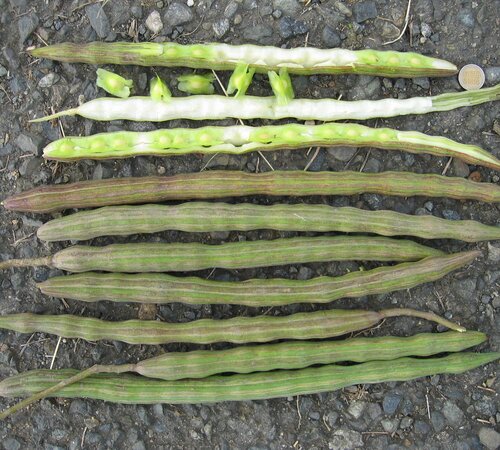Moringa
Moringa oleifera
Crop Overview
Moringa (Moringa oleifera Lam.) is a fast-growing, drought-resistant tree native to the foothills of the Himalayas in northeast Pakistan and northwest India. It is now grown widely across tropical and subtropical regions, including Africa, Central America and the Caribbean, northern countries of South America, South and Southeast Asia and parts of Oceania, including Australia. Moringa is valued for its rapid growth, nutritional value and versatility. Leaves, roots and seeds are all used as food. The leaves also have medicinal uses, containing anti-oxidant, anti-inflammatory, anti-diabetic, lipid-lowering, anti-cancer and anti-bacterial substances.
Common names include horseradish tree, drumstick tree, benzolive tree, kelor tree, mlonge tree, marango tree, saijihan tree, sajna tree and mulangay tree.
Characteristics, Cultivation and Agricultural Practices
Moringa thrives in well-drained sandy or loamy soils and prefers warm, tropical climates with average temperatures between 25 and 35°C. It is highly drought tolerant and can grow in arid and semi-arid regions with minimal water. The tree’s deep root system helps to stabilize soil and its leaves can be used as mulch or green manure, improving soil fertility. Moringa can grow in poor soils, but requires full sun and protection from frost.
The tree grows rapidly, and the leaves in particular, can be harvested several times a year, providing a reliable source of nutritious food.
Moringa is resistant to most pests and diseases in its native range, although some pests have been reported to cause severe loss of leaves in certain areas. These include pod fly (Gitona distigma) and bud worm (Noorda moringae) in southern India, and various caterpillars.
Moringa is commonly cultivated in home gardens, intercropped, in alley cropping systems and in agroforestry. It may also be grown as a monocrop in intensive production systems. Yields vary widely according to the production system, in particular the planting density and harvest frequency, with reports of 30 tonnes of fresh biomass per hectare annually in intensive systems in Nigeria to up to 650 tonnes per hectare annually in southern India. Yields in lower-intensity systems are more commonly in the order of 6 tonnes per hectare annually.
Nutritional, Economic and Medicinal Value
Moringa leaves are rich in B vitamins, vitamins A, C, E and K, calcium, manganese, potassium and protein. The leaves are often consumed fresh, dried, or powdered, and are used in various dishes, providing essential nutrients to local diets. Moringa bark, pods, seeds and flowers are also edible, adding to its culinary versatility. The tree is used to provide feed for livestock.
Moringa also has numerous other applications. The seeds can be processed to extract oil (known as ben oil), which is used in cooking, cosmetics and as a biofuel. Moringa seed powder is also highly effective as a water purifier. The leaves and seeds have been used in traditional medicine to treat various ailments, such as inflammation, diabetes and malnutrition.
Cultural Importance
Moringa holds cultural significance in many societies where it is cultivated. It is widely used in traditional medicine, especially in India and parts of Africa. Its ability to grow in challenging conditions has made it a symbol of resilience in many communities.
Gender Perspectives
Women are often responsible for cultivating and managing moringa in home gardens, where they grow it for nutritional purposes, income generation or both. Men are more involved in commercial moringa cropping.
Why is the Crop Underutilized?
Factors contributing to the underutilization of moringa include lack of improved varieties and cultivation practices, poor access to markets and market information and limited awareness of the tree’s nutritional and economic potential. In many regions, moringa is grown primarily for subsistence rather than as a commercial crop, which restricts its market value and production scalability.
Diversity Available in Genesys
As of December 2024, Genesys, the online information platform about plant genetic resources for food and agriculture conserved in genebanks worldwide, lists 201 samples of Moringa oleifera, 94 of which are landraces and 18 are wild. The largest collections are held by:
- World Vegetable Center – 88 samples.
- Embrapa Recursos Genéticos e Biotecnologia in Brazil – 33 samples.
- The Genetic Resources Research Institute (GeRRI) of the Kenya Agricultural and Livestock Research Organization – 21 samples.
Current Breeding Efforts
To date, no moringa breeding programs have been identified and research is ongoing.


